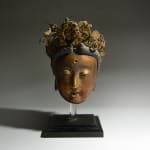Gilt Stucco Head of Kuan-Yin, 960 CE - 1644 CE
Gilt Stucco
height 45.7 cm
height 18 in
height 18 in
H.049
Further images
Cast in exquisite detail, this sculpture of Kuan-Yin i applied with red and black lacquer and gilt in the face and black and blu pigment in the headdress. Her ova...
Cast in exquisite detail, this sculpture of Kuan-Yin i applied with red and black lacquer and gilt in the face and black and blu pigment in the headdress. Her ova face, aquiline nose, pursed lips, and delicately shaped downcast eyes make u her benevolent expression. circular impression on her forehead represents the , a Buddhist mar signifying spiritual enlightenment. Elongate earlobes, another Buddhist mark, symbolized overabundant generosity. Bodhisattvas and Kuan-Yin figures were often adorned with jewele earrings and other dazzling adornments, as may have once been the case with thi figure. A distinctive feature of Kuan-Yin is her elaborat headdress—in this piece depicted by a triangular-shaped tiara, centered on th image of Amitaba Buddha holding a bowl amongst foliate sprigs. The tiara is delicately constructed piece by piece, hel together by wiring exposed in some areas. Th hair is combed and tied up in a knot encircled by the large crown.
The Kuan-Yin is part of the Buddhist constellation o Bodhisattvas, devotees who have attained enlightenment but traverse the earth t promote the teachings of Buddha. Throug divine example of guidance, the Bodhisattvas communicate with the people,
helping them cope with the difficulties of life and attain some measure o spiritual cultivation. Thus, the have become popular subjects for representation, sometimes combining thei attributes with characterizations of indigenous deities or religious beliefs. Kuan-Yin has a strong feminine presence in Chinese art as she is als referred to as the Goddess of Mercy, named after her attributes of compassio and pity.
The Kuan-Yin is part of the Buddhist constellation o Bodhisattvas, devotees who have attained enlightenment but traverse the earth t promote the teachings of Buddha. Throug divine example of guidance, the Bodhisattvas communicate with the people,
helping them cope with the difficulties of life and attain some measure o spiritual cultivation. Thus, the have become popular subjects for representation, sometimes combining thei attributes with characterizations of indigenous deities or religious beliefs. Kuan-Yin has a strong feminine presence in Chinese art as she is als referred to as the Goddess of Mercy, named after her attributes of compassio and pity.





